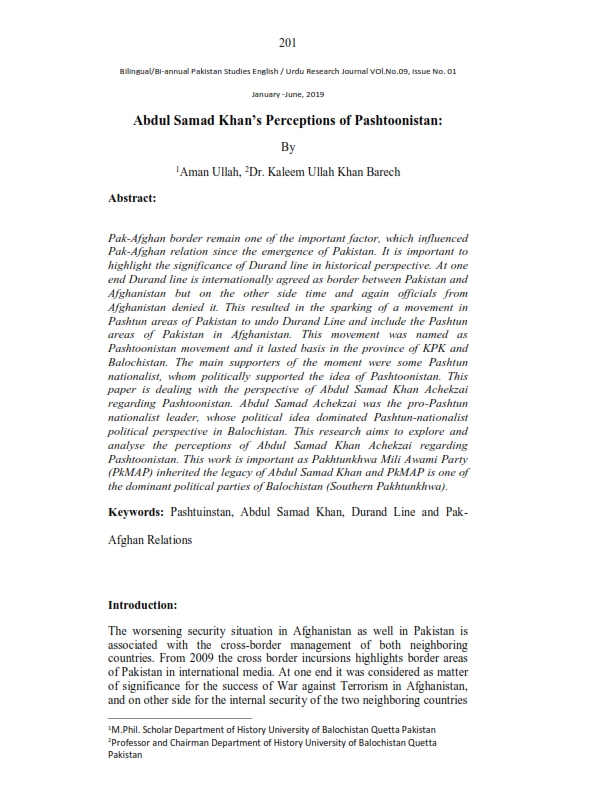Abdul Samad Khan’s Perceptions of Pashtoonistan
Keywords:
Pashtuinstan, Abdul Samad Khan, Durand Line and Pak, Afghan RelationsAbstract
Pak-Afghan border remain one of the important factor, which influenced
Pak-Afghan relation since the emergence of Pakistan. It is important to
highlight the significance of Durand line in historical perspective. At one
end Durand line is internationally agreed as border between Pakistan and
Afghanistan but on the other side time and again officials from
Afghanistan denied it. This resulted in the sparking of a movement in
Pashtun areas of Pakistan to undo Durand Line and include the Pashtun
areas of Pakistan in Afghanistan. This movement was named as
Pashtoonistan movement and it lasted basis in the province of KPK and
Balochistan. The main supporters of the moment were some Pashtun
nationalist, whom politically supported the idea of Pashtoonistan. This
paper is dealing with the perspective of Abdul Samad Khan Achekzai
regarding Pashtoonistan. Abdul Samad Achekzai was the pro-Pashtun
nationalist leader, whose political idea dominated Pashtun-nationalist
political perspective in Balochistan. This research aims to explore and
analyse the perceptions of Abdul Samad Khan Achekzai regarding
Pashtoonistan. This work is important as Pakhtunkhwa Mili Awami Party
(PkMAP) inherited the legacy of Abdul Samad Khan and PkMAP is one of
the dominant political parties of Balochistan (Southern Pakhtunkhwa).
References
Amin, Tahir. (1988). Ethno-National Movements of Pakistan: Domestic
and International Factors. Islamabad: Institute of Policy Studies.
Barth, Fredrik. (1969). Ethnic Groups and Boundaries: The Social
Organization of Culture Difference. Boston: Little, Brown & Co.
Bernard, Cohn. (1985). “The command of language and the language of
command”. In Guha, Ranjit (ed.). Subaltern Studies IV. Delhi:
Oxford University Press. pp. 276-329.
Cheema, Pervaiz Iqbal. “The Afghanistan Crisis and Pakistan's Security
Dilemma” Asian Survey 23, no. 3. Mar., 1983, pp. 227-243,
Daoud,Mohammad. “President and Prime Minister Mohammad Daoud's
interview with Jameel-ur-Rahman, Editor of Daily New Times of
Rawalpindi. Pakistan,” April 29, 1974. Retrieved from web on
March 10, 2017.
http://afghandata.org:8080/xmlui/bitstream/handle/azu/3313/azu_a
cku_pamphlet_ds371_t37_m64_1974_w.pdf;sequence.
Dupree, Louis. (1973). Afghanistan. New Jersey: Princeton University
Press. pp. 538-540.
Ghano, Abdul Ghani Khan. (2003) Baba-e-Pashtoon ka Moqif (Urdu).
Vol, 3. Part, 1. Quetta: Pashtu Adabi Shohba.
Ghano, Abdul Ghani Khan. (2004). Baba-e-Pashtoon ka Moqif (Urdu).
Vol, 4. Quetta: Pashtu Adabi Shohba.
Ghano, Abdul Ghani Khan. (2005). Baba-e-Pashtoon ka Moqif (Urdu).
Vol, 5. Part, 2. Quetta: Pashtu Adabi Shohba.
Hallberg, Daniel G. (1992). Pashto: a sociolinguistic and dialect study.
SSNP, No, 4. Summer 1992. pp. 19-44.
Janjua, Muhammad Qaiser, (2009). In the Shadow of the Durand Line:
Security, Stability, and the Future of Pakistan and Afghanistan.
California: Naval Postgraduate School. Also retrieved from web on
March 29, 2017.
http://www.dtic.mil/dtic/tr/fulltext/u2/a501684.pdf.
Josh, Shabbir Hasan. (1964). Yadon Ki Barat (The wedding procession of
memories), (Urdu). Lahore: Maktaba-e-Sher-o-Adab.
Khan, Abdul Ghafar. (1969). My Life and Struggle: Autobiography of
Badshah Khan. Delhi: Hind Pocket Books Ltd.
Mahmood, Tariq. The Durand Line: South Asia's New Trouble Spot.
Retrieved from web on March 21, 2017.
http://www.ccc.nps.navy.mil/research/theses/Mahmood05.pdf.
Mishra, Manoj Kumar, (2016). “Strategic Depth and Pakistan’s links with
Radical Islamic Groups”, International Journal of Humanities &
Social Science Studies. Volume-II, Issue-VI, May 2016, pp. 98-
Assam: Scholar Publications, Karimganj. Also retrieved from
web on March 29, 2017. http://www.ijhsss.com.
NDC. (1950) “Pakistani Charged Affaires in Kabul to Chief Secretary
NWFP Government”, Memo No. PEK/21/2 in NDC. 4 March
NDC. (1950). “Chief Secretary, NWFP Government to Assistant
Secretary, Government of Pakistan, Ministry of States and Frontier
Regions”, No. 823/STB/128 at NDC. 17 April 1950.
NDC. (1950). “Pathanistan propaganda’ by the Local Administration, 22
August 1950 in NDC).
NDC. (1950). “Political Agent, South Waziristan to the Chief Secretary,
NWFP Government”, D. O. No. 12/S-8/49 in NDC. 19 January
Shah, Syed Waqar. (1992). Muslim League in NWFP. Karachi: Royal
Book Company.
Tareen, Shaukat. (2006). The Politics of Khan Shaheed. Quetta: Qalath
Publishers.
The Great Pashtoon. Quetta: Roz-u-Din Ghaznavi, 2007.
Tendulkar, D. G. (1967). Abdul Ghaffar Khan: Faith is a Battle. Bombay:
Popular Prakashan.
Zaidi, Zawwar H. (1994). Jinnah Papers, 3 June–30 June 1947 Vol. 2. Part
Islamabad: Quaid-i-Azam Papers Project, National Archives of
Pakistan



